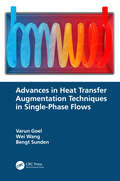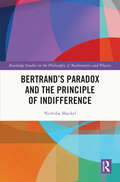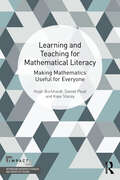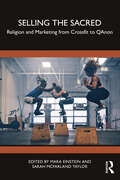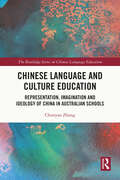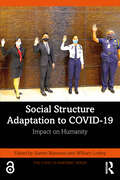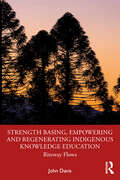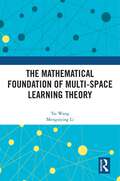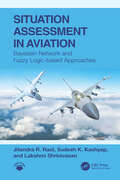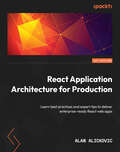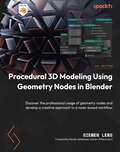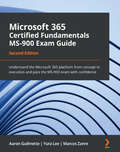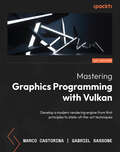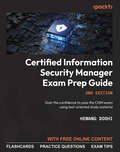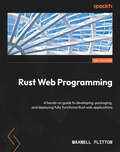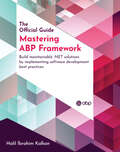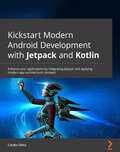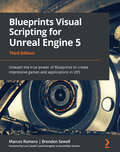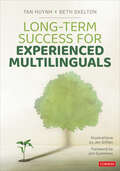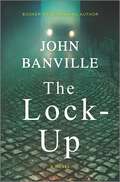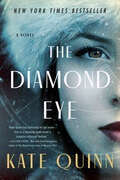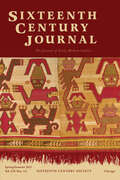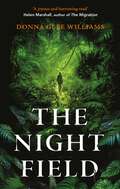- Table View
- List View
Advances in Heat Transfer Augmentation Techniques in Single-Phase Flows
by Varun Goel Wei Wang Bengt SundenAugmentation of heat transfer is important in energy conservation and developing sustainable energy systems. This book provides the science necessary to understand the basics of heat transfer augmentation in single-phase engineering systems. It considers theory and practice including computational and experimental procedures, evaluation techniques for performance, and new trends. Several applications of augmentation methods like surface modification, introduction of vortex flow and impinging jets, opportunities of ultrasound and magnetic fields, pulsatile flows, heat exchangers, and nanofluids are provided. Details of basic phenomena and mechanisms are highlighted.Key features: Provides the fundamental science needed to understand and further develop heat transfer augmentation for future energy systems Give examples of how ultrasound and magnetic fields, vortex flow, impinging jets, surface modification and nanofluids can augment heat transfer Considers basic issues of computational and experimental methods for analysis, design, and evaluation of efficient and sustainable heat transfer It is an ideal reference text for graduate students and academic researchers working in the fields of mechanical, aerospace, industrial, manufacturing, and chemical engineering.
Bertrand’s Paradox and the Principle of Indifference (Routledge Studies in the Philosophy of Mathematics and Physics)
by Nicholas ShackelEvents between which we have no epistemic reason to discriminate have equal epistemic probabilities. Bertrand’s chord paradox, however, appears to show this to be false, and thereby poses a general threat to probabilities for continuum sized state spaces. Articulating the nature of such spaces involves some deep mathematics and that is perhaps why the recent literature on Bertrand’s Paradox has been almost entirely from mathematicians and physicists, who have often deployed elegant mathematics of considerable sophistication. At the same time, the philosophy of probability has been left out. In particular, left out entirely are the philosophical ground of the principle of indifference, the nature of the principle itself, the stringent constraint this places on the mathematical representation of the principle needed for its application to continuum sized event spaces, and what these entail for rigour in developing the paradox itself. This book puts the philosophy and its entailments back in and in so doing casts a new light on the paradox, giving original analyses of the paradox, its possible solutions, the source of the paradox, the philosophical errors we make in attempting to solve it and what the paradox proves for the philosophy of probability. The book finishes with the author’s proposed solution—a solution in the spirit of Bertrand’s, indeed—in which an epistemic principle more general than the principle of indifference offers a principled restriction of the domain of the principle of indifference.Bertrand's Paradox and the Principle of Indifference will appeal to scholars and advanced students working in the philosophy of mathematics, epistemology, philosophy of science, probability theory and mathematical physics.
Learning and Teaching for Mathematical Literacy: Making Mathematics Useful for Everyone (IMPACT: Interweaving Mathematics Pedagogy and Content for Teaching)
by Hugh Burkhardt Daniel Pead Kaye StaceyTypically, most people don’t realize when and how they can use the mathematics they were taught in high school – yet many of the mathematical ideas and skills can be a powerful tool for understanding how the world works. Learning and Teaching for Mathematical Literacy addresses this situation, offering practical strategies for developing a broader vision of mathematical literacy in the classroom and recognising the importance of maintaining these skills into adult life. Linked to the material explored throughout this book, classroom activities and lesson materials are freely available for use via the QR codes included in each chapter.Filled with case studies and classroom activities, chapters tackle several topics: Describing a framework for a broader vision of mathematical literacy – what is it, and why is it important? Teaching mathematical literacy in the classroom Applying mathematical literacy to ‘real life’ scenarios: My dad is buying a new dishwasher. Should he buy the extended warranty on offer? My phone works fine but I've been offered an upgrade. How should I decide whether to take it? The role of technology in teaching mathematical literacy Designing mathematical measures for real-word quantities Firmly grounded by practical applications for the classroom and beyond, this is an essential handbook for any teacher, teaching assistant, or mathematics subject lead who wishes to develop their students’ mathematical literacy skills. This is also an ideal resource for those delivering or enrolled in teacher preparation courses.
Selling the Sacred: Religion and Marketing from Crossfit to QAnon
by Mara Einstein Sarah McFarland TaylorThere’s religion in my marketing! There’s marketing in my religion! Selling the Sacred explores the religio-cultural and media implications of a two-sided phenomenon: marketing religion as a product and marketing products as religion. What do various forms of religion/marketing collaboration look like in the twenty-first century, and what does this tell us about American culture and society?Social and technological changes rapidly and continuously reframe religious and marketing landscapes. Crossfit is a “cult.” Televangelists use psychographics and data marketing. QAnon is a religion and big business. These are some of the examples highlighted in this collection, which engages themes related to capitalist narratives, issues related to gender and race, and the intersection of religion, politics, and marketing, among other key issues.The innovative contributors examine the phenomenon of selling the sacred, providing a better understanding of how marketing tactics, married with religious content, influence our thinking and everyday lives. These scholars bring to light how political, economic, and ideological agendas infuse the construction and presentation of the “sacred,” via more traditional religious institutions or consumer-product marketing. By examining religion and marketing broadly, this book offers engaging tools to recognize and unpack what gets sold as “sacred,” what’s at stake, and the consequences.A go-to resource for those working in marketing studies, religious studies, and media studies, Selling the Sacred is also a must-read for religious and marketing professionals.
Chinese Language and Culture Education: Representation, Imagination and Ideology of China in Australian Schools (The Routledge Series on Chinese Language Education)
by Chunyan ZhangAgainst the background of the Australian government’s strategic plan to promote Asian languages in schools, this book is an innovative autoethnographic inquiry into what actually occurs in the implementation of a Chinese language and culture program in an Australian context.Drawing on eight years of socio-cultural and educational fieldwork in a primary school, Chunyan Zhang examines complex, fluid and heterogeneous daily teaching practices and the ways in which ideas of China are assembled, presented and performed. She asks the following questions: What is China? Where does Taiwan fit into the China depicted in a multicultural, globalised classroom? Can Chinese communism or Chairman Mao be avoided in teaching English-speaking learners? What kind of China is brought in here while what kind of China is being silenced and othered? Through the partial connection between method assemblage and Daoist concepts, Zhang develops a water-like pedagogy in teaching. She uses the knowledge flow model to examine the imbalanced knowledge flow within teacher-student interactions. From finding China as a hybrid assemblage to proposing China as method, Zhang’s investigation makes an important contribution to the sociology of Chinese language education.This book is an essential and rich content resource for primary and secondary teacher education and research, teacher candidates and educators in Chinese as a second language education.
Social Structure Adaptation to COVID-19: Impact on Humanity (The COVID-19 Pandemic Series)
by Suresh Nanwani William LoxleySocial Structure Adaptation to COVID-19 offers global, interdisciplinary perspectives that examine how the COVID-19 pandemic has altered the development trajectory of schools, public health, the workforce, and technology adoption. It explores social themes in society, economy, policy, and culture and draws on a social framework to describe key functions of societal adaptation to the pandemic.Edited by Suresh Nanwani and William Loxley, the volume is grounded in the study of system components and their objectives to improve overall well-being given the ill effects of the COVID-19 pandemic. Chapters explore interconnected social networks and how sectors restructured themselves to stabilize or transform society. International contributors from 20 countries offer case studies that highlight key themes including personal connectivity, societal equality, well-being, big data, and national resilience. They predict how impactful the pandemic might be in reshaping the future and assess how the COVID-19 pandemic has affected school system shutdown, public health collapse, business closures, public policy failure, and technology-driven social media acceleration.Offering insights into how institutions and sectors work together in times of crisis, and how COVID-19 has restructured social behavior, Social Structure Adaptation to COVID-19 will be valuable reading for scholars and students of sociology, political science, anthropology, comparative international development, psychology, and education. It will also be of interest to policymakers concerned with education, work and organizations, and media and technology.The Open Access version of this book, available at www.taylorfrancis.com, has been made available under a Creative Commons Attribution-Non Commercial-No Derivatives (CC-BY-NC-ND) 4.0 international license.
Strength Basing, Empowering and Regenerating Indigenous Knowledge Education: Riteway Flows
by John DavisStrength Basing, Empowering and Regenerating Indigenous Knowledge Education demonstrates how to bring Indigenous Knowledges to the forefront of education practice and provides educators with the tools to enact culturally responsive curricula and pedagogies, ensuring positive educational outcomes for Aboriginal and Torres Strait Islander children and students. In this book, John Davis presents Indigenous Knowledges – ways of doing, creating, and learning – combined with contemporary education practice, to develop a culturally responsive pedagogy that builds on the strengths that Indigenous Australian students bring to the classroom. Setting Cultural Proficiency as the benchmark, the book offers educators a lens through which to review their education practice. It moves beyond the deficit model of Indigenous education by challenging non-Indigenous educators to reflect on personal biases and to raise their expectations of Indigenous students. Not ‘tacked on’ to an existing curriculum, or specific to a single school term or unit of learning, Riteway places Indigenous Knowledges at the centre of education. The approach is holistic and adaptable to any educational context, from the early years right through to tertiary education. Providing a roadmap toward transformational education for Aboriginal and Torres Strait Islander children and students, this book will be essential reading for pre- and in-service educators alike.
The Mathematical Foundation of Multi-Space Learning Theory
by Tai Wang Mengsiying LiThis book explores the measurement of learning effectiveness and the optimization of knowledge retention by modeling the learning process and building the mathematical foundation of multi-space learning theory.Multi-space learning is defined in this book as a micro-process of human learning that can take place in more than one space, with the goal of effective learning and knowledge retention. This book models the learning process as a temporal sequence of concept learning, drawing on established principles and empirical evidence. It also introduces the matroid to strengthen the mathematical foundation of multi-space learning theory and applies the theory to vocabulary and mathematics learning, respectively. The results show that, for vocabulary learning, the method can be used to estimate the effectiveness of a single learning strategy, to detect the mutual interference that might exist between learning strategies, and to predict the optimal combination of strategies. In mathematical learning, it was found that timing is crucial in both first learning and second learning in scheduling optimization to maximize the intersection effective interval.The title will be of interest to researchers and students in a wide range of areas, including educational technology, learning sciences, mathematical applications, and mathematical psychology.
Situation Assessment in Aviation: Bayesian Network and Fuzzy Logic-based Approaches
by Jitendra R. Raol Sudesh K. Kashyap Lakshmi ShrinivasanSituation Assessment in Aviation focuses on new aspects of soft computing technologies for the evaluation and assessment of situations in aviation scenarios. It considers technologies emerging from multisensory data fusion (MSDF), Bayesian networks (BN), and fuzzy logic (FL) to assist pilots in their decision-making.Studying MSDF, BN, and FL from the perspective of their applications to the problem of situation assessment, the book discusses the development of certain soft technologies that can be further used for devising more sophisticated technologies for a pilot's decision-making when performing certain tasks: airplane monitoring, pair formation, attack, and threat. It explains the concepts of situation awareness, data fusion, decision fusion, Bayesian networks, fuzzy logic type 1, and interval type 2 fuzzy logic. The book also presents a hybrid technique by using BN and FL and a unique approach to the problem of situation assessment, beyond visual range and air-to-air combat, by utilizing building blocks of artificial intelligence (AI) for the future development of more advanced automated systems, especially using commercial software.The book is intended for aerospace R&D engineers, systems engineers, aeronautical engineers, and aviation training professionals. It will also be useful for aerospace and electrical engineering students taking courses in Air Traffic Management, Aviation Management, Aviation Operations, and Aviation Safety Systems.
Team Player (Wondergirls #2)
by Jillian BrooksME, competitive? Can I help it if I score the MOST goals, wear the COOLEST clothes, and throw the best PARTIES? I'm not competitive... that's just who I am. And I'm definitely not SELFISH. So how come certain people—like my BEST friends—keep telling ME that I am? I can be NICE... When I feel like it. RL 4 Ages 8-12 Look for the other books in the wondergirls series about the friendship of four girls at home and at middle school including: #1 The New Girl, #3 Troublemaker, #4 "And The Winner Is...", #5 Perfect Harmony, and #7 Birthday Blues, with more on the way
React Application Architecture for Production: Learn best practices and expert tips to deliver enterprise-ready React web apps
by Alan AlickovicA hands-on guide to help you develop skills and confidence in building and structuring React applications in a well-organized way using the best tools in the React ecosystemKey FeaturesDiscover solutions to complex problems faced while creating production-ready apps with ReactDevelop scalable React applications with Next.js using a step-by-step approach from analysis to deploymentGet an overview of the React ecosystem and identify the best tools to meet your app requirementsBook DescriptionBuilding large-scale applications in production can be overwhelming with the amount of tooling choices and lack of cohesive resources. To address these challenges, this hands-on guide covers best practices and web application development examples to help you build enterprise-ready applications with React in no time.Throughout the book, you'll work through a real-life practical example that demonstrates all the concepts covered. You'll learn to build modern frontend applications—built from scratch and ready for production. Starting with an overview of the React ecosystem, the book will guide you in identifying the tools available to solve complex development challenges. You'll then advance to building APIs, components, and pages to form a complete frontend app. The book will also share best practices for testing, securing, and packaging your app in a structured way before finally deploying your app with scalability in mind.By the end of the book, you'll be able to efficiently build production-ready applications by following industry practices and expert tips.What you will learnUse a good project structure that scales well with your applicationCreate beautiful UIs with Chakra UI and emotionConfigure a base Next.js app with static code analysis and Git hooksLearn to mock API endpoints for prototyping, local development and testingChoose an optimal rendering strategy in Next.js based on the page needsLearn to choose the best state management solution for given problemWrite unit tests, integration tests and e2e tests in your React ApplicationDeploy your React applications on VercelWho this book is forThis book is for intermediate-level web developers who already have a solid understanding of JavaScript, React, and web development in general and want to build large-scale React applications effectively. Beginner-level TypeScript experience, along with JavaScript and React, will be beneficial.
Procedural 3D Modeling Using Geometry Nodes in Blender: Discover the professional usage of geometry nodes and develop a creative approach to a node-based workflow
by Siemen Lens Wouter AdriaensenAn easy-to-follow, illustrated guide to learning the geometry nodes editor and various other facets of geometry nodes through simple exercises that progress to more challenging projectsPurchase of the print or Kindle book includes a free PDF eBookKey FeaturesDevelop a creative mathematical thinking of the modeling workflowUnderstand how Blender and geometry nodes store and manage the data that you are handlingLearn different scatter methods and how to use themBook DescriptionFor anyone working in the computer graphics industry, understanding how to use Blender's new geometry nodes tools to manipulate and generate 3D geometry in a node-based workflow is an essential skill. In this book, you'll learn how to use the basic and intermediate features of geometry nodes that are a crucial part of your Blender roadmap.You'll start by understanding the different node inputs and outputs followed by the basic nodes you'll need throughout your geometry nodes projects. The book will show you how the node system works and enable you to put your newfound knowledge to use through exercises that involve modifying curves, meshes, and more. You'll work on a range of interesting projects such as creating a procedural plant, where you'll use nodes to generate the intricate details and variations of a plant in a procedural manner, and a spiderweb generator to refine your skills of cleaning up a node tree. Finally, you'll build a procedural LED panel using geometry nodes to generate the look of an LED panel.By the end of this book, you'll be able to overcome any geometry node issue confidently and make complicated geometry node trees exactly how you need them.What you will learnDiscover the different node inputs and outputs that geometry nodes have to offerGet the hang of the flow of the geometry node systemUnderstand the common nodes you'll be using along with their functions in the geometry node editorModify basic mesh primitives using the node system inside BlenderScatter and modify objects aligned onto a curveBecome familiar with the more advanced nodes in the geometry nodes systemLink geometry and material nodes editors using named attributesImplement your new-found knowledge of nodes in real-world projectsWho this book is forIf you are a CG Artist or follow modeling careers like that of an environment artist or even a CG generalist in the cinematography industry and you are looking to get into learning a node-based modeling workflow using Geometry Nodes in Blender, this is the perfect book for you. You will need a basic knowledge of the fundamentals of Blender, for example, knowing the specific workflow of material nodes and being able to apply this knowledge to your projects. To get the most out of this book, you should have a basic understanding of Blender's shortcut system and some modeling experience.
Microsoft 365 Certified Fundamentals MS-900 Exam Guide: Understand the Microsoft 365 platform from concept to execution and pass the MS-900 exam with confidence, 2nd Edition
by Aaron Guilmette Yura Lee Marcos ZanreExplore the latest MS-900 exam skills and concepts with this updated second editionKey FeaturesWork with self-assessment questions, exam tips, and mock tests based on the latest exam patternThis updated second edition covers concepts including Microsoft Forms, Microsoft 365 Security Center, and moreUnderstand the security considerations and benefits of adopting different types of cloud servicesBook DescriptionMicrosoft 365 Certified Fundamentals certification demonstrates your foundational knowledge of adopting cloud services, specifically the software as a service (SaaS) model. Exam MS-900 tests your understanding of Microsoft 365 services, components, their implementation, security, licensing, and general cloud concepts. This updated second edition covers all the recent and important changes in the examination in detail to help you achieve certification. You'll begin by exploring key topics such as Microsoft security and compliance policies, pricing and support, and cloud concepts. The book helps you to understand these concepts with the help of real-world scenarios, learning about platform services such as Microsoft Windows, SharePoint, Microsoft 365 apps, Teams, and Exchange. The content has been updated to include Microsoft Forms, Power Platform, Microsoft 365 Security Center, Windows Virtual Desktop, and Insider Risk Management. Each chapter contains a section that will test your knowledge of the core concepts covered. Finally, you'll take a practice exam with extra questions to help prepare you for the actual test. By the end of this MS-900 book, you'll be well-equipped to confidently pass the MS-900 certification exam with the help of the updated exam pattern.What you will learnUnderstand cloud services and deployment models, including public and private cloudsFind out the differences between SaaS and IaaS consumption models, and where Microsoft services fit inExplore the reporting and analytics capabilities of Microsoft 365Use Compliance Manager and Security Center to audit your organizationDiscover and implement best practices for licensing options available in Microsoft 365Gain insights into the exam objectives and knowledge required before taking the MS-900 examWho this book is forThis book is for intermediate as well as experienced administrators and individuals looking for tips and tricks to pass the latest MS-900 exam and achieve Microsoft 365 certification. Basic knowledge of Microsoft services and cloud concepts is assumed in order to get the most out of this book.
Mastering Graphics Programming with Vulkan: Develop a modern rendering engine from first principles to state-of-the-art techniques
by Marco Castorina Gabriel SassoneDevelop a rendering framework by implementing next-generation 3D graphics, leveraging advanced Vulkan features, and getting familiar with efficient real-time ray tracing techniques uncovered by leading industry expertsKey FeaturesDevelop high-performance rendering techniques in VulkanAutomate some of the more tedious aspects like pipeline layouts and resource barriersUnderstand how to take advantage of mesh shaders and ray tracingBook DescriptionVulkan is now an established and flexible multi-platform graphics API. It has been adopted in many industries, including game development, medical imaging, movie productions, and media playback. Learning Vulkan is a foundational step to understanding how a modern graphics API works, both on desktop and mobile. In Mastering Graphics Programming with Vulkan, you'll begin by developing the foundations of a rendering framework. You'll learn how to leverage advanced Vulkan features to write a modern rendering engine. The chapters will cover how to automate resource binding and dependencies. You'll then take advantage of GPU-driven rendering to scale the size of your scenes and finally, you'll get familiar with ray tracing techniques that will improve the visual quality of your rendered image. By the end of this book, you'll have a thorough understanding of the inner workings of a modern rendering engine and the graphics techniques employed to achieve state-of-the-art results. The framework developed in this book will be the starting point for all your future experiments.What you will learnUnderstand resources management and modern bindless techniquesGet comfortable with how a frame graph works and know its advantagesExplore how to render efficiently with many light sourcesDiscover how to integrate variable rate shadingUnderstand the benefits and limitations of temporal anti-aliasingGet to grips with how GPU-driven rendering worksExplore and leverage ray tracing to improve render qualityWho this book is forThis book is for professional graphics and game developers who want to gain in-depth knowledge about how to write a modern and performant rendering engine in Vulkan. Familiarity with basic concepts of graphics programming (i.e. matrices, vectors, etc.) and fundamental knowledge of Vulkan are required.
Certified Information Security Manager Exam Prep Guide: Gain the confidence to pass the CISM exam using test-oriented study material, 2nd Edition
by Hemang DoshiMaster information security fundamentals with comprehensive explanations of concepts.Purchase of the book unlocks access to web-based tools like practice questions, flashcards, and more to take your CISM prep to the next level.Purchase of the print or Kindle book includes a free eBook in PDF format.Key FeaturesUse this comprehensive resource to prepare for ISACA's CISM certificationUnlock free online tools including interactive practice questions, exam tips, and flashcards to effectively prepare for the CISM examUnderstand the theory behind information security program development and managementBook DescriptionCISM is a globally recognized and much sought-after certification in the field of IT security. This second edition of the Certified Information Security Manager Exam Prep Guide is up to date with complete coverage of the exam content through comprehensive and exam-oriented explanations of core concepts. Written in a clear, succinct manner, this book covers all four domains of the CISM Review Manual.With this book, you'll unlock access to a powerful exam-prep platform which includes interactive practice questions, exam tips, and flashcards. The platform perfectly complements the book and even lets you bring your questions directly to the author.This mixed learning approach of exploring key concepts through the book and applying them to answer practice questions online is designed to help build your confidence in acing the CISM certification.By the end of this book, you'll have everything you need to succeed in your information security career and pass the CISM certification exam with this handy, on-the-job desktop reference guide.What you will learnUnderstand core exam objectives to prepare for the CISM exam with confidenceGet to grips with detailed procedural guidelines for effective information security incident managementExecute information security governance in an efficient mannerStrengthen your preparation for the CISM exam using interactive flashcards and practice questionsConceptualize complex topics through diagrams and examplesFind out how to integrate governance, risk management, and compliance functionsWho this book is forIf you're an IT professional, IT security officer, or risk management executive looking to upgrade your career by passing the CISM exam, this book is for you. Basic familiarity with information security concepts is required to make the most of this book.
Rust Web Programming: A hands-on guide to developing, packaging, and deploying fully functional Rust web applications, 2nd Edition
by Maxwell FlittonUse the Rust programming language to build fully functional web applications with async Rust to amplify security and boost the performance of your programsKey FeaturesWork with cutting-edge web techniques such as distroless Rust servers, Terraform, and AWS deploymentGet acquainted with async concepts such as actors and queuing tasks using lower-level frameworks like TokioBuild a full web application in Rust with a database, authentication, and frontendBook DescriptionAre safety and high performance a big concern for you while developing web applications?With this practical Rust book, you'll discover how you can implement Rust on the web to achieve the desired performance and security as you learn techniques and tooling to build fully operational web apps.In this second edition, you'll get hands-on with implementing emerging Rust web frameworks, including Actix, Rocket, and Hyper. It also features HTTPS configuration on AWS when deploying a web application and introduces you to Terraform for automating the building of web infrastructure on AWS. What's more, this edition also covers advanced async topics. Built on the Tokio async runtime, this explores TCP and framing, implementing async systems with the actor framework, and queuing tasks on Redis to be consumed by a number of worker nodes. Finally, you'll go over best practices for packaging Rust servers in distroless Rust Docker images with database drivers, so your servers are a total size of 50Mb each.By the end of this book, you'll have confidence in your skills to build robust, functional, and scalable web applications from scratch.What you will learnStructure and build scalable Rust web apps by creating a basic to-do list web appManage authentication and databases in Rust web applicationsGet to grips with wrapping web applications in distrolessUnderstand the building blocks of web development such as HTTPS, TCP, and middlewareBuild app infrastructure on AWS using Terraform with databases, servers, load balancers, HTTPS, and URL routingBuild end-to-end tests using PostmanBuild async systems implementing the actor model using TokioWho this book is forThis Rust programming book is for web developers who want to learn and implement Rust to build web applications. Developers familiar with languages such as Python, Ruby, and JS will be able to use this book to build high performant web apps with Rust.Although no prior experience in Rust is necessary, a solid understanding of web development principles, along with basic knowledge of HTML, CSS, and JavaScript, is necessary to get the most out of this book.
Mastering ABP Framework: Build maintainable .NET solutions by implementing software development best practices
by Halil Ibrahim Kalkan Ismail CAGDASLearn how to build modern web applications from the creator of ABP FrameworkKey FeaturesBuild robust, maintainable, modular, and scalable software solutions using ABP FrameworkLearn how to implement SOLID principles and domain-driven design in your web applicationsDiscover how ABP Framework speeds up your development cycle by automating repetitive tasksBook DescriptionABP Framework is a complete infrastructure for creating modern web applications by following software development best practices and conventions. With ABP's high-level framework and ecosystem, you can implement the Don't Repeat Yourself (DRY) principle and focus on your business code. Written by the creator of ABP Framework, this book will help you to gain a complete understanding of the framework and modern web application development techniques. With step-by-step explanations of essential concepts and practical examples, you'll understand the requirements of a modern web solution and how ABP Framework makes it enjoyable to develop your own solutions. You'll discover the common requirements of enterprise web application development and explore the infrastructure provided by ABP. Throughout the book, you'll get to grips with software development best practices for building maintainable and modular web solutions. By the end of this book, you'll be able to create a complete web solution that is easy to develop, maintain, and test.What you will learnSet up the development environment and get started with ABP FrameworkWork with Entity Framework Core and MongoDB to develop your data access layerUnderstand cross-cutting concerns and how ABP automates repetitive tasksGet to grips with implementing domain-driven design with ABP FrameworkBuild UI pages and components with ASP.NET Core MVC (Razor Pages) and BlazorWork with multi-tenancy to create modular web applicationsUnderstand modularity and create reusable application modulesWrite unit, integration, and UI tests using ABP FrameworkWho this book is forThis book is for web developers who want to learn software architectures and best practices for building maintainable web-based solutions using Microsoft technologies and ABP Framework. Basic knowledge of C# and ASP.NET Core is necessary to get started with this book.
Kickstart Modern Android Development with Jetpack and Kotlin: Enhance your applications by integrating Jetpack and applying modern app architectural concepts
by Catalin GhitaExplore modern Android development in Kotlin 1.6.10 with this condensed hands-on guide to building reliable apps using libraries such as Compose, ViewModel, Hilt, Retrofit, Flow, and moreKey FeaturesExplore Jetpack libraries and other modern technologies for Android developmentImprove the architectural design of your Android appsEnhance the quality of your Android projects' code bases and applications using the latest librariesBook DescriptionWith Jetpack libraries, you can build and design high-quality, robust Android apps that have an improved architecture and work consistently across different versions and devices. This book will help you understand how Jetpack allows developers to follow best practices and architectural patterns when building Android apps while also eliminating boilerplate code. Developers working with Android and Kotlin will be able to put their knowledge to work with this condensed practical guide to building apps with the most popular Jetpack libraries, including Jetpack Compose, ViewModel, Hilt, Room, Paging, Lifecycle, and Navigation. You'll get to grips with relevant libraries and architectural patterns, including popular libraries in the Android ecosystem such as Retrofit, Coroutines, and Flow while building modern applications with real-world data. By the end of this Android app development book, you'll have learned how to leverage Jetpack libraries and your knowledge of architectural concepts for building, designing, and testing robust Android applications for various use cases.What you will learnIntegrate popular Jetpack libraries such as Compose, ViewModel, Hilt, and Navigation into real Android apps with KotlinApply modern app architecture concepts such as MVVM, dependency injection, and clean architectureExplore Android libraries such as Retrofit, Coroutines, and FlowIntegrate Compose with the rest of the Jetpack libraries or other popular Android librariesWork with other Jetpack libraries such as Paging and Room while integrating a real REST API that supports paginationTest Compose UI and the application logic through unit testsWho this book is forThis book is for junior and intermediate-level Android developers looking to level up their Android development skills to develop high-quality apps using Jetpack libraries and other cutting-edge technologies. Beginners with knowledge of Android development fundamentals will also find this book useful. Familiarity with Kotlin is assumed.
Blueprints Visual Scripting for Unreal Engine 5: Unleash the true power of Blueprints to create impressive games and applications in UE5
by Marcos Romero Brenden SewellExplore the faster way to build games using UE5 Blueprints using this practical guide with key images printed in colorKey FeaturesDesign a fully functional game in UE5 without writing a single line of codeImplement visual scripting to develop gameplay mechanics, UI, visual effects, VR, and artificial intelligenceDeploy your game on multiple platforms and share it with the worldBook DescriptionUnreal Engine's Blueprint visual scripting system enables designers to script their games and programmers to create base elements that can be extended by designers. With this book, you'll explore all the features of the Blueprint Editor, along with expert tips, shortcuts, and best practices. The book guides you through using variables, macros, and functions, and helps you learn about object-oriented programming (OOP). You'll discover the Gameplay Framework and advance to learning how Blueprint Communication allows one Blueprint to access information from another Blueprint. Later chapters focus on building a fully functional game step by step. You'll start with a basic first-person shooter (FPS) template, and each chapter will build on the prototype to create an increasingly complex and robust game experience. You'll then progress from creating basic shooting mechanics to more complex systems such as user interface elements and intelligent enemy behavior. The book demonstrates how to use arrays, maps, enums, and vector operations and introduces the elements needed for VR game development. In the final chapters, you’ll learn how to implement procedural generation and create a product configurator. By the end of this book, you'll have learned how to build a fully functional game and have the skills required to develop an entertaining experience for your audience.What you will learnUnderstand programming concepts in BlueprintsCreate prototypes and iterate new game mechanics rapidlyBuild user interface elements and interactive menusUse advanced Blueprint nodes to manage the complexity of a gameExplore all the features of the Blueprint editor, such as the Components tab, Viewport, and Event GraphGet to grips with OOP concepts and explore the Gameplay FrameworkWork with virtual reality development in UE BlueprintImplement procedural generation and create a product configuratorWho this book is forThis book is for anyone interested in developing games or applications with UE5. Although basic knowledge of Windows OS is required, experience in programming or UE5 is not necessary.
Long-Term Success for Experienced Multilinguals
by Tan Huynh Beth SkeltonAffirm the linguistic, cultural, and experiential assets that multilinguals bring into the classroom. Now is the time to push past the limits of the long-term English learner (LTEL) label and embrace a new way of honoring secondary multilinguals’ valuable life experiences and academic potential. By focusing on experienced multilinguals’ strengths and what teachers can do, you’ll discover new avenues for teaching the academic language skills required for them to process content lessons and clearly communicate discipline-specific ideas. This concise guide presents an easy-to-implement cross-curricular instructional framework specifically designed for secondary content teachers. Practical, research-based, and classroom-tested this book includes: Four essential actions that foster the conditions for experienced multilinguals to reach the highest grade-level content and language proficiency Specific strategies with "try it out" prompts to encourage implementation Templates and anchor charts for structuring lessons Vignettes and stories from both the student and teacher perspective There is nothing lacking with experienced multilinguals. All they need are the right conditions to unlock their potential—so they can express themselves as the mathematicians, scientists, historians, writers, and artists they know themselves to be.
Long-Term Success for Experienced Multilinguals
by Tan Huynh Beth SkeltonAffirm the linguistic, cultural, and experiential assets that multilinguals bring into the classroom. Now is the time to push past the limits of the long-term English learner (LTEL) label and embrace a new way of honoring secondary multilinguals’ valuable life experiences and academic potential. By focusing on experienced multilinguals’ strengths and what teachers can do, you’ll discover new avenues for teaching the academic language skills required for them to process content lessons and clearly communicate discipline-specific ideas. This concise guide presents an easy-to-implement cross-curricular instructional framework specifically designed for secondary content teachers. Practical, research-based, and classroom-tested this book includes: Four essential actions that foster the conditions for experienced multilinguals to reach the highest grade-level content and language proficiency Specific strategies with "try it out" prompts to encourage implementation Templates and anchor charts for structuring lessons Vignettes and stories from both the student and teacher perspective There is nothing lacking with experienced multilinguals. All they need are the right conditions to unlock their potential—so they can express themselves as the mathematicians, scientists, historians, writers, and artists they know themselves to be.
The Lock-Up: A Detective Mystery
by John Banville*NATIONAL BESTSELLER*A New York Times Editors' ChoiceBooker Prize winner and &“Irish master&” (The New Yorker) John Banville&’s most ambitious crime novel yet brings two detectives together to solve a globe-spanning mysteryIn 1950s Dublin, Rosa Jacobs, a young history scholar, is found dead in her car. Renowned pathologist Dr. Quirke and DI St. John Strafford begin to investigate the death as a murder, but it&’s the victim&’s older sister Molly, an established journalist, who discovers a lead that could crack open the case.One of Rosa&’s friends, it turns out, is from a powerful German family that arrived in Ireland under mysterious circumstances shortly after World War II. But as Quirke and Strafford close in, their personal lives may put the case—and everyone involved—in peril, including Quirke&’s own daughter.Spanning the mountaintops of Italy, the front lines of World War II Bavaria, the gritty streets of Dublin and other unexpected locales, The Lock-Up is an ambitious and arresting mystery by one of the world&’s most celebrated authors.
The Diamond Eye: A Novel
by Kate QuinnNew York Times BestsellerThe bestselling author of The Rose Code returns with an unforgettable World War II tale of a quiet bookworm who becomes history’s deadliest female sniper. Based on a true story.In 1937 in the snowbound city of Kyiv, wry and bookish history student Mila Pavlichenko organizes her life around her library job and her young son—but Hitler’s invasion of Ukraine and Russia sends her on a different path. Given a rifle and sent to join the fight, Mila must forge herself from studious girl to deadly sniper—a lethal hunter of Nazis known as Lady Death. When news of her three hundredth kill makes her a national heroine, Mila finds herself torn from the bloody battlefields of the eastern front and sent to America on a goodwill tour.Still reeling from war wounds and devastated by loss, Mila finds herself isolated and lonely in the glittering world of Washington, DC—until an unexpected friendship with First Lady Eleanor Roosevelt and an even more unexpected connection with a silent fellow sniper offer the possibility of happiness. But when an old enemy from Mila’s past joins forces with a deadly new foe lurking in the shadows, Lady Death finds herself battling her own demons and enemy bullets in the deadliest duel of her life.Based on a true story, The Diamond Eye is a haunting novel of heroism born of desperation, of a mother who became a soldier, of a woman who found her place in the world and changed the course of history forever.
The Sixteenth Century Journal, volume 54 number 1-2 (Spring 2023)
by The Sixteenth Century JournalThis is volume 54 issue 1-2 of The Sixteenth Century Journal. The Sixteenth Century Journal (SCJ) publishes research and inquiry related to the sixteenth century broadly defined (1450-1650) in all fields and all world regions. The international readership and authorship of the SCJ include leaders in their fields as well as early career scholars. As its subtitle, The Journal of Early Modern Studies, indicates, the SCJ is an interdisciplinary journal, with articles in history, art history, literature, religious studies, gender studies, the history of science, music, material culture, and many other fields.
The Night Field: A magnificent and moving ecological fable
by Donna Glee WilliamsAn incredible story of one woman's jounrey to save her people - and the world. 'One of those novels that just sings in your ears . . . a joyous and harrowing read' - Helen Marshall, author of THE MIGRATIONUpdated with all-new material and a reading-group guide.It comes without warning, without explanation - the sudden deadly Stink that shreds the life of the People, poisoning the land, sickening the trees, killing babies in the womb. It comes from above, from the Plains of the Ancestors, but what has caused this murderous curse?It falls to Pyn-Poi to find out. The young tree-woman must climb the unclimbable cliff, to face the Ancestors on their own ground and demand an accounting for the Stink.But the end of the climb is just the beginning of Pyn-Poi's journey. What she finds in the world above is an abomination beyond the most fearsome fire-stories of the People - and she must defeat it, or face the extinction of everything she has ever loved.Praise for The Night Field'Simple, beautiful prose' Scott T. Barnes, editor of NewMyths.com magazine'Masterful storytelling' Karin Lacey, The Uncommon Octopus'Beautifully written, poetic' Susan Sachs, climate education mentor
